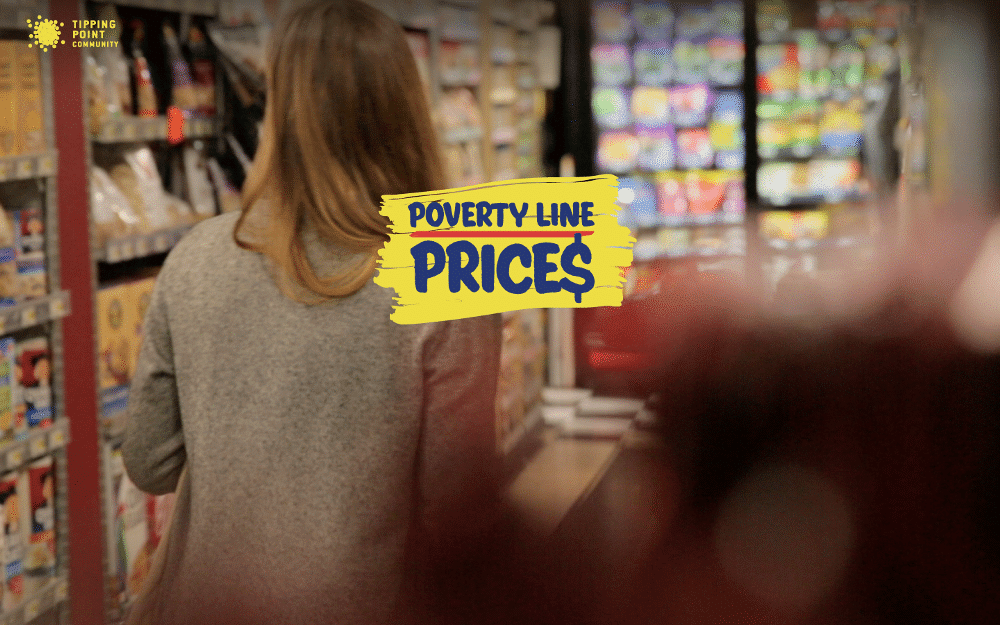NOVEMBER 17, 2016 (SAN FRANCISCO, CA) – In San Francisco, the average annual family income is $153,000, and after taxes is nearly five times the $24,300 a year that families living on the poverty line have to survive on. Today, this is a reality for 1 in 10 families struggling to make ends meet in the city with the highest rent in the country.
It’s hard to break the cycle of poverty when the budget barely covers the basics. To shed light on what it feels like to live with so few financial resources, Tipping Point Community, a leading poverty-fighting organization in the Bay Area, is introducing “Poverty Line Prices,” an awareness campaign timed with the holiday giving season.
For the past 11 years, Tipping Point has rigorously screened and invested in the most promising non-profits educating, employing, housing and supporting people in the Bay Area who are too poor to meet their basic needs. Last year alone, Tipping Point helped put 22,000 people on a path out of poverty.
The campaign, which was developed in partnership with Bay Area advertising agency Goodby Silverstein & Partners (GS&P), demonstrates the cost of living in poverty, by showing how every day necessities are approximately five times as expensive as they are for a family making the average Bay Area salary.
For a family living on the poverty line, milk that costs almost $5 feels as if it costs $24. A $23 Thanksgiving turkey becomes $114. A $73 monthly bus pass is the equivalent of $362. And one semester’s worth of college books, $584, becomes a staggering $2,894—a poignant reminder of how difficult it can be to break the cycle of poverty.
“Every day, more than one million Bay Area residents are forced to choose between putting food on the table and paying the rent, buying medicine and paying for school books. And, lack of financial resources is just one of the many challenges facing those living below the poverty line,” said Daniel Lurie, CEO + Founder of Tipping Point Community.
“In a region with so many resources and so much creativity, we simply have to do more to help break the cycle of multigenerational poverty in the Bay Area.”
An online film was created to bring the experience of living in poverty to life by capturing the reactions of shoppers as they purchased groceries with prices inflated by 500%. The film was shot at a grocery store in Nob Hill—one of San Francisco’s most affluent neighborhoods, where, Zillow estimates, the median rent is $5,242 per month, and the average home price is $1.39 million.
The film drives to www.tippingpoint.org, where users can enter their salaries or use the San Francisco average to see how much more expensive items ranging from rent to schoolbooks to groceries would feel if they were living on the poverty line. Users are also encouraged to donate to Tipping Point through the site by donating the value of basic needs that have been marked-up according to their salary. Information about the campaign can also be shared on social channels by using the hashtag #povertylineprices.
The campaign will also appear through strategically placed contextual media buys. On the Wednesday before Thanksgiving, leading up to Black Friday, the busiest shopping day of the year, coupon inserts featuring marked-up prices will run in the San Francisco Chronicle. The inserts will resemble grocery store flyers, showing items with the inflated prices to reflect what it feels like for those living on the poverty line.
“The Bay Area is a tale of two cities: the haves and the have-nots,” said Rich Silverstein, co-chairman and partner of GS&P. “We wanted people to get a small sense of the reality of living on the poverty line to truly understand the importance of Tipping Point’s mission.”
“Poverty Line Prices” is one of many socially minded national campaigns created by GS&P. Most recently, the agency created the “Unacceptable Acceptance Letters” campaign, which raised awareness about sexual assault on college campuses; and the antibullying effort “I Am a Witness,” the first emoji linked to a social cause.
ABOUT THE MATH:
To calculate the inflated Poverty Line Prices, GS&P’s strategy team took the average price of necessities in the area and calculated what percentage of a take-home paycheck each item would represent for a family living on the poverty line. The percentage of salary required to purchase each item was then applied to the (much higher) average San Francisco take-home salary for families. For example, if eggs cost $6, the adjusted price would be $30—reflecting the percentage of weekly income that eggs cost for those living in poverty.
This process highlights the fact that as take-home salaries drop, the percentage of one’s salary spent on necessary items increases.
The poverty guideline is a federal standard, and the San Francisco average is from the US Census Bureau. The average item costs were provided by expatistan.com, and the national price for textbooks was provided by collegeboard.org.
###
About Tipping Point Community
Since 2005, Tipping Point Community has raised more than $120 million to educate, employ, house and support those in need in the Bay Area, putting 22,000 people on the path out of poverty in the last year alone. Tipping Point screens non-profits rigorously to find, fund and partner with the most promising groups helping low-income people achieve self-sufficiency. Beyond dollars, they provide grantees with the communications, technical and management assistance they need to grow and increase their impact in the fight against poverty. Because the Board of Directors covers all fundraising and operations costs, 100% of every dollar donated goes out the door.



